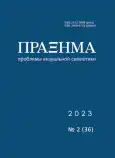Science is a specific and even unbelievable, I would say paradoxical, kind of human activity, just like any functional system in modern society. It is accepted that science establishes truth, but this truth is not true, as evidenced by Popper’s criterion of falsifiability. Another problem is the distinction between science as a social system and cognitive activity, so that much of modern scientific work may have nothing to do with cognition at all, but only with the self-reproduction of the social system. Finally, modern science also essentially differs from everything from which its genesis is usually deduced: firstly from primitive mythological not even cognition, but consciousness; then from primary philosophical views with attempts of objective descriptions sewn into them; then from theories verified by scholasticism; and, finally, from classic science, which actually underlies all sciences, forming in the Enlightenment era the concept of object and method of scientific experiment. Science as cognition is a process. Science as a social system is also a process. In these processes we fix from time to time reference points that allow us to describe them in terms of a certain universal position, which different philosophical orientations define differently. Among other things, I believe, the notion of orientation in the environment fits the role of such a position. Cognition and its accompanying science then appear as a system of a more and more complex orientation, the complexity of which at one end rests on uncertainty, which can be represented in the real concept of complexity or, metaphorically, in the image of quantum metaphor as quantum entanglement, and, at the other, in the unreal concept of absolute abstraction, which perhaps could be imagined – if it were possible! – as a sign cleared of content. Such a form is best characterized by the paradoxical word/notion of “nothingness.” Just as we do not have complexity and its physical representative, entanglement, although we really deal with its derivatives – collapsed forms of things (like the electron in the double-slit experiment), so even less do we have absolute abstractions (like, say, the already mentioned “truth”), although we work with unreal concepts, of which, on occasion, only a sign remains. Thus, a point can be a real point placed with chalk on the blackboard in the classroom, or it can be an unreal “mathematical point,” which a handful of chalk on the blackboard only symbolizes. Orientation ultimately collapses into four reference points, which form a fractal tuple that unfolds in any subject in which we wish to orient ourselves, including the individual consciousness or system of science. These orientations are given, schemata, positions, and “nothingness” (beyond the horizon of these orientations there remain indeterminacy and absolute abstraction). The pattern of classical science, which defines the typology of science in general, relies on three reference points: the researcher observes from a certain position the data of the world and describes them through theories (schemata), which are verified through scientific experiment. Briefly, it looks like this: position => schemas => data. In essence, this is the type/pattern of natural sciences. A new type of sciences – the humanities – is characterized by the exact opposite vector in the same pattern: position = schemata = data. In this case, in fact, with the emergence of the humanities it became possible to speak of a scientific and cognitive typology at all, since the beginning of the formation of the notion of the observer (as opposed to the natural science subject) was laid here, thanks to which real reference points were transformed into conditional, typologically relative ones. Thus, the humanitarian observer observes/describes positions as given – thus the pattern of classical (natural) science is realized, but science itself becomes different – it has another subject of research and another view (position) from which it proceeds. These two points – the position of observation and the subject of research – determine the type of science. In this case, the hierarchical picture of the world created by the natural (classical, enlightened) sciences becomes networked. Now, by combining the reference points in different combinations, we get an orientation in the types of modern science and cognition, including the non-classical and post-non-classical sciences described by Vyacheslav Stepin. The non-classical includes the theoretical sciences (natural and humanitarian). An example of natural theoretical sciences is theoretical physics or biosemiotics; an example of humanities theoretical sciences is theoretical sociology and psychotherapy theory. The post-non-classical includes general theories (also natural theories and humanities). An example of natural general theories is general systems theory and synergetics; an example of humanitarian general theories is hermeneutics and semiotics.
 9-29
9-29


 30-49
30-49


 50-73
50-73


 74-80
74-80


 81-94
81-94


 95-102
95-102


 103-114
103-114


 115-124
115-124











